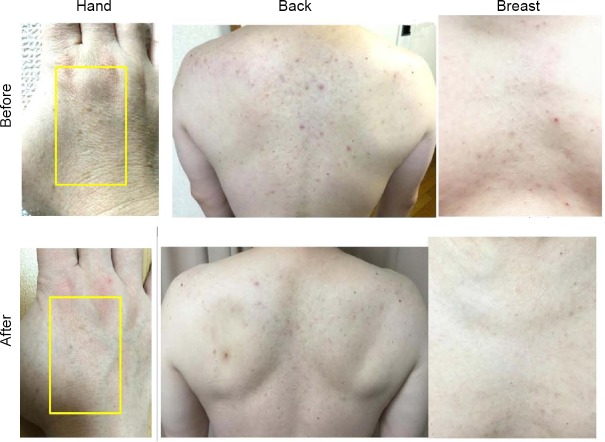Abstract
Hydrogen-dissolved water has been shown to improve diverse oxidation stress-related diseases, which drove us to examine effects of hydrogen-rich water on oxidation stress-related skin troubles and lipid-metabolism markers. The purpose of this study is whether the dissolved hydrogen in hydrogen-rich water was kept even after boiling, and whether hydrogen-bath utilization improves cosmetic effects such as skin-blotch repression and the visceral-fat-based slimming effects. The subjects were two men and two women, aged 48, 43, 42, and 41 years (n = 4). They took warm (41°C) water bath of dissolved hydrogen 300–310 μg/L (< 10 μg/L for normal water) for 10-minute once daily for 1–6 months, followed by examination of skin blotch, visceral fat, and cholesterol and glucose metabolisms. The dissolved hydrogen concentration was measured after 15-minute boiling and the subsequent cooling naturally. The wide-ranging, dense, and irregularly shaped skin blotches became markedly smaller and thinner, assumedly through reductive bleaching of melanin and lipofuscin and promotion of dermal cell renewal by the hydrogen-rich warm water. Ultrasonic resonance-based analysis on the abdominal cross-section revealed that the visceral fat area decreased from 47 to 36 cm2, and the abdominal circumference decreased from 91 to 82 cm, in the two female subjects bathing in hydrogen-water. After 6-month hydrogen-water bathing, the low-density lipoprotein cholesterol level was decreased by 16.2% and the fasting blood glucose level increased by 13.6% in the blood of a female subject. Before boiling, the dissolved hydrogen and an oxidation-reduced potential were 300 μg/L and –115 mV, respectively. Dissolved hydrogen was retained at 300–175 μg/L and 200 μg/L, even 1–6 hours and 24 hours, respectively, after boiling. Therefore, a hydrogen-rich water-bath apparatus can electrolytically generate abundant boiling-resistant hydrogen bubbles, improving visceral fat and blotches on the skin. The study was approved by the Medical Ethics Committee of the Japanese Center for Anti-Aging Medical Sciences and that was officially authenticated by the Hiroshima Prefecture Government of Japan (approval number 15C1) in 2016.
Keywords: hydrogen-rich water, reactive oxygen species, skin blotches, visceral fat area, metabolic markers, bath apparatus, cosmetic effects, slimming effects
INTRODUCTION
The size of the hydrogen molecule is the smallest of all substances, and it easily penetrates the cell membrane. There is no concern about side effects when hydrogen that is stable and inactive is put into the body.1 Therefore the safety of drinking hydrogen-rich water was confirmed by its lack of mutagenic, genetically toxic or subacute body toxic properties.1 Furthermore, hydrogen-rich water removes reactive oxygen species (ROS), a trace of which can lead to tumor cell growth, according to electron paramagnetic resonance/spin trap and the redox indicator dichloro-dihydro-fluorescein diacetate assay.2,3 It may serve as daily skin care to prevent ultraviolet A-induced skin damages through ROS scavenging and promotion of type I collagen synthesis in the dermis.4 Colloidal platinum dispersed in hydrogen-rich water markedly exhibits radical-scavenging activity (compared with individual treatment) and improves blood fluidity in a micro-channel array blood-flow rheology apparatus.5 However, in the conventional manufacturing method, hydrogen is immediately released because there is no basis for hydrogen adsorption. Normal tap water contains hydrogen below the lower limit of detection of a dissolved hydrogen (DH) concentration meter. We developed functional water containing hydrogen nano-bubbles that are approximately 10 times more abundant than those of conventional electrode-generated hydrogen-rich water.6 Hydrogen-rich water has been suggested to be effective for alleviating oxidative stress.7 It has improved antioxidant activity, and its nano-bubbles are markedly more important than hydrogen concentration in terms of its hydroxyl radical (•OH)–scavenging property.8 In our method of electrolysis, the electrode-surface-gilding platinum or the released platinum ions adsorb hydrogen molecules and stabilizes for a long time. This is because platinum ions were yielded at 514 ng/L in 30-minute-electrolytic aqueous solution, in contrast to being undetectable before electrolysis, according to an inductively coupled plasma-mass spectrometric method (our unpublished data). Therefore, even after boiling, hydrogen was abundantly dissolved as the exception for Henry’s law, and could be efficiently utilized for a hydrogen-rich water bath.9
We aimed to investigate the effects of hydrogen-rich water bath based on the improvement of the cosmetic state of the skin, repression of visceral fat, and activation of cholesterol and glucose metabolism.
SUBJECTS AND METHODS
Subjects
The subjects were two men and two women, aged 48, 43, 42, and 41 years. The exclusion criteria were regarded for the incidence of some illness, drop-out during the examination of daily hydrogen-bathing, or intake of some anti-oxidant supplements. The research was officially approved in 2016 with an approval number of 15C1, under conditions of noninvasive research such as no hemorrhage, painless treatment, and no trace/sign, using a commercially available apparatus, by the Medical Ethics Committee of the Japanese Center for Anti-Aging Medical Sciences and was officially authenticated by the Hiroshima Prefecture Government of Japan. All participants provided informed consent.
Apparatus
Premium SPA type PSP0001 (Sanyu Co., Ltd., Osaka, Japan) was used to generate hydrogen bubbles through the equipped electrode into the bathtub filled with 180–200 L of tap water. A washbowl, for facial treatment, was also supplied with hydrogen bubbles.
The DH concentration was 300–175 μg/L, which was reduced to and remained at 70 μg/L after boiling for 15 minutes; in contrast, the DH concentration of tap water is reduced to < 10 μg/L). The oxidation-reduction potential (ORP) was –115 mV to –79 mV (cf. +494 mV for tap water).
Examination of the effects of hydrogen-rich water bath
Blotch-control facial cleansing
The subject was a 43-year-old man with wide-ranging spots on his left cheek. The bump of the spots was neither outstanding nor left-right symmetrical. Because the spots were near the cheekbones, they were presumed to be senile pigment spots. The subject immersed his left cheek in warm (40°C) hydrogen-rich water for 15 minutes three times a week for 7 months using the facial washbowl. Additionally, he immersed his left cheek in room-temperature hydrogen-rich water for 10 minutes once a week.
Decreasing blotches on the legs
The subject was a 41-year-old woman with many wide-ranging mottled stains on the left lower leg. She immersed her left leg in warm (41°C) hydrogen-rich water bath for 10 minutes once a day for 1 month.
Skin improvement
The subject was a 48-year-old woman with dotted spots on the right hand. Furthermore, the skin of the subject was always dry and she had pimples on the back and on the breast for many years. She immersed her body in warm (41°C) hydrogen-rich water bath for 10 minutes once a day for 1 month.
Improvement of visceral fat
The subjects were a 48-year-old man and 41- and 42-year-old women with excessive weight gain and large waist size. They immersed their body in warm (41°C) hydrogen-rich water bath for 10 minutes once a day for 3 months. The subjects underwent specific health checkups at a hospital before the test and after the 3-month test. The visceral fat was examined using ultrasonic resonance-based DualScan (Omron Healthcare Co., Ltd., Kyoto, Japan).10,11
Improvement of cholesterol and glucose metabolism
The subject was a 41-year-old woman. She immersed her body in warm (41°C) hydrogen-rich water bath for 10 minutes once a day for 6 months. The subject underwent specific health checkups at a hospital before the test and after the 3- and 6-month tests. Blood biochemical test was done to examine high- and low-density lipoprotein cholesterol and fasting blood glucose.
During these examinations, the subjects did not change their daily habits including meal contents and the exercise except their usage of a hydrogen-rich water bath.
Time-course examination of the water characteristic parameters in hydrogen-rich water
For the high-concentration hydrogen-rich water bath, 6 L of tap water was placed in the facial washbowl and was electrolyzed for 30 minutes. Before boiling, the DH and an oxidation-reduction potential (ORP) were 300 μg/L and –115 mV, respectively. After boiling the hydrogen-rich water, four water parameters (DH, dissolved oxygen [DO] concentration, ORP, and pH) were measured along with electrolytic times. Measurement was done after return to normal temperature, after 1 hour, after 3 hours, after the maximum possible time, and after 24 hours.
As for the return to normal temperature, two methods were carried out (rapid and natural cooling), and the effective one was measured three times.
RESULTS
Hydrogen-rich water decreases the facial blotch
The effects of hydrogen-rich water treatment on wide-ranging facial blotches are shown in Figure 1. After hydrogen immersion for 7 months and 8 days, the longstanding (25 years), wide-ranging, and irregularly shaped spots became smaller and thinner. The lower region of the blotch range almost disappeared. It was presumed that the skin layers containing melanin and lipofuscin, which cause spots, were expelled out of the skin surface as dirt through activated keratinocyte proliferation and/or were reductively bleached by the whitening power of hydrogen.
Figure 1.
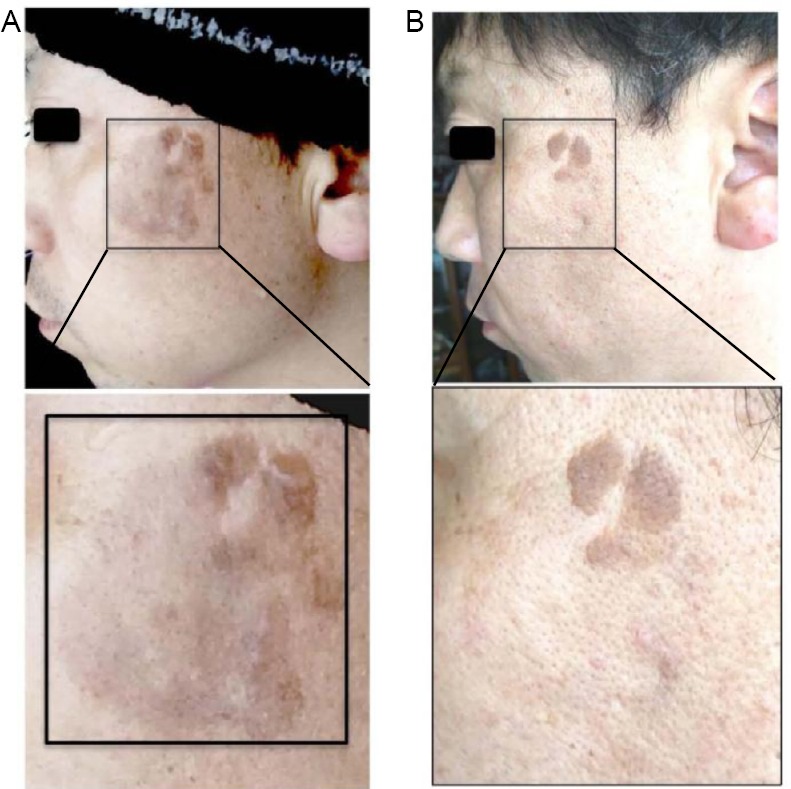
The blotch-decreasing effect of facial cleansing with hydrogen-rich water.
Note: The male, 43 years old, with an informed consent. Immersion in hydrogen-rich water at 40°C for 15 minutes was performed three times a week. Additionally, immersion in hydrogen-rich water at room temperature for 10 minutes was performed once a week. (A) Before hydrogen-rich water treatment. (B) Seven months after hydrogen-rich water treatment, wide range spots that have not been healed in his 25-year life became smaller and thinner after the test.
Hydrogen-rich water decreases the leg skin blotch
The effects of hydrogen-rich water bath treatment on decreasing blotches are shown in Figure 2. After immersing in hydrogen-rich water bath once a day for 1 month, the spots decreased and the densely brownish color became lighter.
Figure 2.
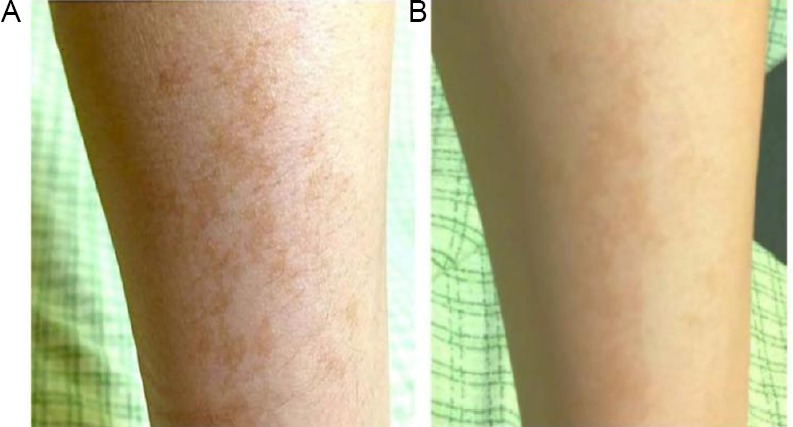
The blotch-decreasing effect on the skin by hydrogen-rich water bath.
Note: The female, 41 years old, with her informed consent. Immersion in warm hydrogen-rich water bath (41°C) for 10 minutes was performed once a day for 1 month. (A) Before hydrogen-rich water treatment. (B) One month after hydrogen-rich water treatment, the spots decreased and the densely brownish color became lighter.
Hydrogen-rich water improves the skin appearance
Effects and improvements on the skin after hydrogen-rich water bath treatment are shown in Figure 3. After 1 month, the dense colored spots became lighter, concurrently with moisturized feeling, texture adjustment, and transparent appearance. Furthermore, the pimples on the back and on the breast disappeared considerably and the redness diminished.
Figure 3.
The blotch-decreasing effect and improvements on the skin by hydrogen-rich water bath.
Note: The male, 48 years old, with his informed consent. Immersion in warm hydrogen-rich water bath (41°C) for 10 minutes was performed once a day for 1 month. The yellow boxes enclose the spots to be tested.
Hydrogen-rich water decreases the visceral fat
The suppressive effects on the visceral fat are shown in Figure 4. Before the test, two transverse wrinkles and four radial wrinkles around the navel and abdominal bulge near the belt were observed. One month after starting the test, the abdominal circumference decreased from 79 to 74 cm and the abdominal wrinkles disappeared. After 3 months of hydrogen-rich water immersion, the visceral fat area decreased from 47 to 36 cm2 and the belly of the subjects who were originally slender became firmer (Figure 4A). The suppressive effects on another subject are shown in Figure 4B. After a month of hydrogen-rich water bathing, the abdominal circumference decreased from 91 to 82 cm.
Figure 4.
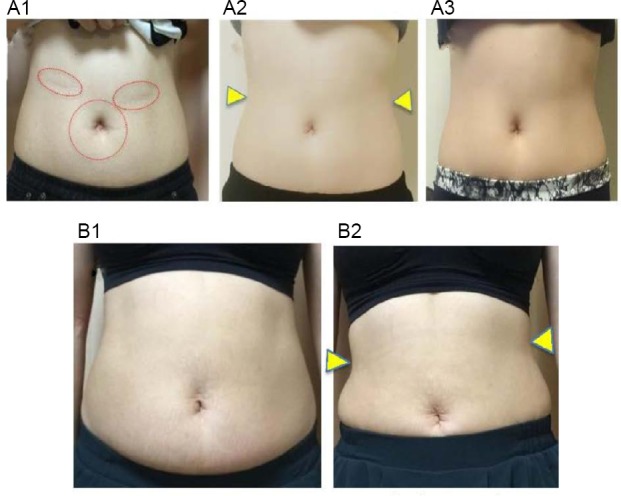
The suppressive effect of hydrogen-rich water bath on the visceral fat.
Note: Immersion in hydrogen warm water bath (41°C) for 10 minutes was performed once a day for 1 month. The subject does not change her meal contents and the exercise except that she used a hydrogen-rich water bath. (A) The female, 41 years old, with her informed consent. (A1–3) Before, 1 month, and 3 months after hydrogen-rich water treatment, respectively. The red circles indicate two transverse wrinkles and four radial wrinkles around the navel. (B) The female, 42 years old, with her informed consent. (B1, 2) Before and a month after hydrogen-rich water treatment, respectively. The yellow triangles indicate waist curves.
Table 1 shows the effect of hydrogen-rich water bath on the improvement to visceral fat. The visceral fat areas of subjects 1 and 3 decreased after 3 months and the belly of subjects became firmer.
Table 1.
Effects of hydrogen-rich water bath on the visceral fat (cm2)
| Subject | Gender | Age (years) | Before hydrogen-rich water treatment | 3 months after hydrogen-rich water treatment |
|---|---|---|---|---|
| 1 | Male | 48 | 99 | 76 |
| 2 | Female | 42 | 47 | 47 |
| 3 | Female | 41 | 47 | 36 |
Note: Immersion in warm hydrogen-rich water bath of 41°C for 10 minutes was performed once a day for 3 months. The subjects did not change their meal contents and the exercise except their daily usage of a hydrogen-rich water bath.
Effects of hydrogen-rich water bath on cholesterol and glucose metabolism
The effects of hydrogen-rich water bath on cholesterol and glucose metabolism of subject 3 are shown in Table 2. Results of the blood biochemical test revealed that the low-density lipoprotein-cholesterol level decreased markedly after 6 months and that the fasting blood glucose level also improved.
Table 2.
Improving effects of hydrogen-rich water bath on cholesterol and glucose metabolism
| Item | Before the test | After 3 months | After 6 months |
|---|---|---|---|
| High-density lipoprotein cholesterol (mg/dL) | 64 | 63 | 53 |
| Low-density lipoprotein cholesterol (mg/dL) | 132 | 138 | 109 |
| Fasting blood glucose (mg/dL) | 103 | 100 | 89 |
Note: The female, 42 years old, with her informed consent. Bathing in warm hydrogen-rich water bath of 41°C for 10 minutes was performed once a day for 6 months.
Time-course of the water characteristic parameters of freshly prepared hydrogen-rich water and after boiling
Before boiling, the DH and ORP were 300 μg/L and –115 mV, respectively. After boiling, DH showed high concentrations (300–175 μg/L) 1–6 hours after preparation and maintained a concentration of 200 μg/L even after 24 hours (Figure 5A). These data were obtained from the measurement using a highly reliable dissolved-hydrogen-concentration-meter of the diaphragm polarography electrode type. Even after boiling for 15 minutes, the DH was maintained at > 70 μg/L, but this was surprising that hydrogen bubbles easily evaporate with increased temperatures, according to Henry’s law, indicating that the hydrogen bubbles were nano-sized and of high quality. After boiling, the DH concentration after 3–6 hours was more abundant in reinforced quenching for 5 minutes rather than in natural cooling for 2 hours.
Figure 5.
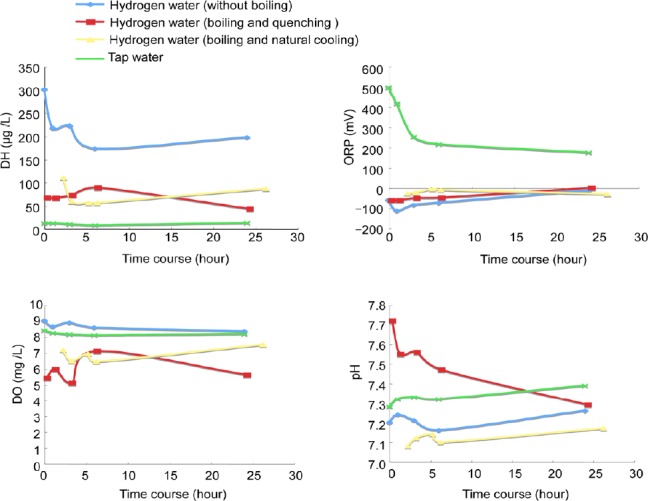
The time course of the water characteristic parameters in hydrogen-rich water boiled or left without temperature intervention.
Note: Six liters of tap water was supplied in the facial washbowl for the high concentration hydrogen-rich water bath and electrolyzed for 30 minutes, and four kinds of water characteristic parameters were measured over time. (A–D) Dissolved hydrogen (DH), oxidation-reduction potential (ORP), dissolved oxygen (DO) concentration, pH in hydrogen-rich water, respectively.
The redox potential of hydrogen-rich water reached the maximum (–115 mV) at 1 hour after preparation and had a strong reduction power (Figure 5B). Even after boiling for 15 minutes, it retained the reduction power for up to 6 hours after quenching.
The DO in hydrogen-rich water was not very different from that of tap water and it was a reduction power by the DH itself (Figure 5C). The DO of the hydrogen-rich water boiled for 15 minutes significantly decreased from 9.0 to 5.4 ppm. After boiling, the DO increased again, more remarkably by natural cooling rather than by quenching, and quenching is presumably preferable rather than natural cooling because peroxidation of some potently active ingredients by DO can be prevented.
The pH of the hydrogen-rich water prepared in the present study is “body-friendly physiological pH” and is closer to neutral pH than tap water (Figure 5D). The pH only increased to ~7.71 transiently just after boiling, but it reached a more neutral pH (up to the physiological pH of 7.29) upon quenching.
DISCUSSION
The lightening and size-reduction of the spots and the improved skin quality are considered to be largely contributed to the ROS-scavenging ability of the abundant DH in hydrogen-rich water bath.
Electrolysis of water produces hydrogen, but if hydrogen molecules gather together, they become hydrogen gas aggregates (macro-bubbles) and cannot be abundantly and durably dissolved in water. However, the device used can produce nano-sized hydrogen molecule clusters and abundantly dissolve hydrogen. This DH reacts with ROS, resulting in reductive conversion to water, which is considered to bring about skin quality improvement. Similarly, it has been reported that inhibitions by hydrogen-occluding silica microcluster to melanogenesis in human pigment cells and to tyrosinase reaction.12 However, in this method, hydrogen is immediately released because there is no basis for hydrogen adsorption. In our method of electrolysis, the electrode-surface-gilding platinum or the released platinum ions adsorb hydrogen molecules and stabilize for a long time. Therefore, it is possible to hold hydrogen while bathing. Furthermore, 3-month use of hydrogen-rich water bath decreases the subjects’ abdominal circumference and visceral fat. The mechanism assumed for cellulite formation and its hydrogen-attributed preventive effect are shown in Figure 6. Cellulite formation is considered to be suppressed by the inhibitory effect of hydrogen on the formation of lipid droplets, oxidative stress, and excessive oxidation.
Figure 6.
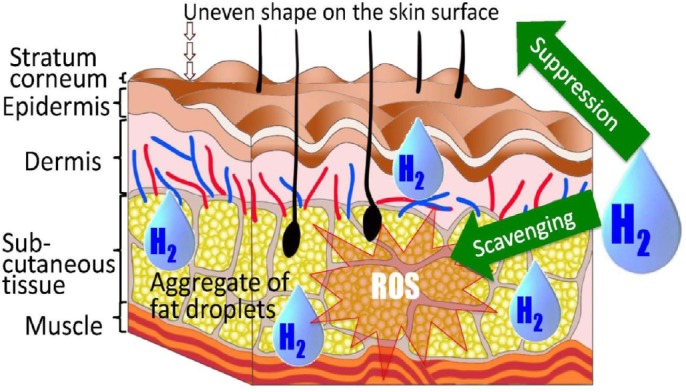
Mechanism assumed for cellulite formation and its hydrogen (H2)-attributed suppression.
Note: Cellulite is presumed to be formed by (1) abnormally excessive accumulation of lipid droplets in adipocytes, (2) adipocyte cell death resulting from loading of oxidative stress to lipid droplets, (3) excessive oxidation of extracellular fat preceded by release of intracellular fat into the extracellular space, and (4) protrusion of the skin surface due to deterioration or solidification of fat. Cellulite formation is considered to be suppressed by the inhibitory effect of hydrogen on the formation of lipid droplets, oxidative stress, and excessive oxidation. ROS: Reactive oxygen species.
Blood biochemical examination of the subjects showed that lipid metabolism improved and the LDL cholesterol level lowered. Hydrogen-rich water bath is presumed to help hydrogen to permeate the blood through the hair pores, sebaceous glands, and sweat pores in the skin, resulting in the dilatation of the subcutaneous capillaries under the skin, thus increasing subcutaneous blood flow. Therefore, hydrogen-rich water bath was considered to be more capable of increasing antioxidative activity in the blood compared with other methods and that it can improve lipid metabolism. In theory, higher DH concentrations cause more powerful abilities for ROS-scavenging. Interestingly, according to Henry’s law, if the water temperature increases, hydrogen evaporates, thus decreasing gas-dissolving capacities. However, the present study showed that more than 70 μg/L DH was maintained even after 15 minutes of boiling, which was regarded as an exception for Henry’s law, owing to boiling resistance of nano-bubbles but not macro-bubbles. The electrolytically generated hydrogen-rich water is majorly occupied by nano-bubbles of 20–290 nm in diameter with 6.9–9.9 × 107 nanoparticles/mL, according to the method of trailing the laser-irradiated nanoparticles (our unpublished data). Furthermore, after 15-minute boiling and the subsequent rapid-cooling, the ORP values continued to have a reducing power for 6 hours, thus proving that it was decisively different from tap water.
Based on these results, taking a hydrogen-rich water bath that produces abundant DH helps hydrogen permeate into the body from the skin and improves the visceral fat area, the lipid metabolic markers and the skin blotch being attributed to boiling-resistant hydrogen bubbles through ROS removal.
Acknowledgements
The authors would express our gratitude to Ms. Haruko Mimura from Faculty of Life and Environmental Sciences, Prefectural University of Hiroshima for her technical assistance.
Footnotes
Funding: The study was partly supported by the Scientific Research on Anti-Aging Promotion from the NPO Corporate (authenticated by Hiroshima Prefectural Government) Japanese Center for Anti-Aging MedSciences, No. 1604 (to RA).
Conflicts of interest
None.
Financial support
The study was partly supported by the Scientific Research on Anti-Aging Promotion from the NPO Corporate (authenticated by Hiroshima Prefectural Government) Japanese Center for Anti-Aging MedSciences, No. 1604 (to RA).
Institutional review board statement
The study was approved in 2016 with an approval number of 15C1 by the Medical Ethics Committee of the Japanese Center for Anti-Aging Medical Sciences.
Declaration of patient consent
The authors certify that they have obtained all appropriate patient consent forms. In the form the patients have given their consent for patients’ images and other clinical information to be reported in the journal. The patients understand that their names and initials will not be published and due efforts will be made to conceal their identity, but anonymity cannot be guaranteed.
Copyright license agreement
The Copyright License Agreement has been signed by the author before publication.
Data sharing statement
Datasets analyzed during the current study are available from the corresponding author on reasonable request.
Plagiarism check
Checked twice by iThenticate.
Peer review
Externally peer reviewed.
REFERENCES
- 1.Saitoh Y, Harata Y, Mizuhashi F, Nakajima M, Miwa N. Biological safety of neutral-pH hydrogen-enriched electrolyzed water upon mutagenicity, genotoxicity and subchronic oral toxicity. Toxicol Ind Health. 2010;26:203–216. doi: 10.1177/0748233710362989. [DOI] [PubMed] [Google Scholar]
- 2.Saitoh Y, Okayasu H, Xiao L, Harata Y, Miwa N. Neutral pH hydrogen-enriched electrolyzed water achieves tumor-preferential clonal growth inhibition over normal cells and tumor invasion inhibition concurrently with intracellular oxidant repression. Oncol Res. 2008;17:247–255. doi: 10.3727/096504008786991620. [DOI] [PubMed] [Google Scholar]
- 3.Asada R, Kageyama K, Tanaka H, et al. Antitumor effects of nano-bubble hydrogen-dissolved water are enhanced by coexistent platinum colloid and the combined hyperthermia with apoptosis-like cell death. Oncol Rep. 2010;24:1463–1470. doi: 10.3892/or_00001006. [DOI] [PubMed] [Google Scholar]
- 4.Kato S, Saitoh Y, Iwai K, Miwa N. Hydrogen-rich electrolyzed warm water represses wrinkle formation against UVA ray together with type-I collagen production and oxidative-stress diminishment in fibroblasts and cell-injury prevention in keratinocytes. J Photochem Photobiol B. 2012;106:24–33. doi: 10.1016/j.jphotobiol.2011.09.006. [DOI] [PubMed] [Google Scholar]
- 5.Kato S, Hokama R, Okayasu H, Saitoh Y, Iwai K, Miwa N. Colloidal platinum in hydrogen-rich water exhibits radical-scavenging activity and improves blood fluidity. J Nanosci Nanotechnol. 2012;12:4019–4027. doi: 10.1166/jnn.2012.6163. [DOI] [PubMed] [Google Scholar]
- 6.Ma M, Paredes A, Bong D. Intra- and intermembrane pairwise molecular recognition between synthetic hydrogen-bonding phospholipids. J Am Chem Soc. 2008;130:14456–14458. doi: 10.1021/ja806954u. [DOI] [PubMed] [Google Scholar]
- 7.Saitoh Y, Yoshimura Y, Nakano K, Miwa N. Platinum nanocolloid-supplemented hydrogendissolved water inhibits growth of human tongue carcinoma cells preferentially over normal cells. Exp Oncol. 2009;31:156–162. [PubMed] [Google Scholar]
- 8.Xiao L, Miwa N. Hydrogen-rich water achieves cytoprotection from oxidative stress injury in human gingival fibroblasts in culture or 3D-tissue equivalents, and wound-healing promotion, together with ROS-scavenging and relief from glutathione diminishment. Hum Cell. 2017;30:72–87. doi: 10.1007/s13577-016-0150-x. [DOI] [PubMed] [Google Scholar]
- 9.Kato S, Matsuoka D, Miwa N. Antioxidant activities of nano-bubble hydrogen-dissolved water assessed by ESR and 2,2’-bipyridyl methods. Mater Sci Eng C Mater Biol Appl. 2015;53:7–10. doi: 10.1016/j.msec.2015.03.064. [DOI] [PubMed] [Google Scholar]
- 10.Ryo M, Maeda K, Onda T, et al. A new simple method for the measurement of visceral fat accumulation by bioelectrical impedance. Diabetes Care. 2005;28:451–453. doi: 10.2337/diacare.28.2.451. [DOI] [PubMed] [Google Scholar]
- 11.Ida M, Hirata M, Odori S, et al. Early changes of abdominal adiposity detected with weekly dual bioelectrical impedance analysis during calorie restriction. Obesity (Silver Spring) 2013;21:E350–353. doi: 10.1002/oby.20300. [DOI] [PubMed] [Google Scholar]
- 12.Kato S, Saitoh Y, Miwa N. Inhibitions by hydrogen-occluding silica microcluster to melanogenesis in human pigment cells and tyrosinase reaction. J Nanosci Nanotechnol. 2013;13:52–59. doi: 10.1166/jnn.2013.6848. [DOI] [PubMed] [Google Scholar]



